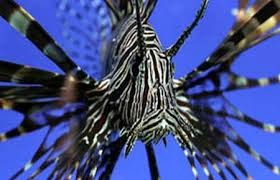Red lionfish
(Pterois miles)

Description
The red lionfish (Pterois volitans) is a venomous coral reef fish in the family Scorpaenidae, order Scorpaeniformes. It is mainly native to the Indo-Pacific region, but has become an invasive species in the Caribbean Sea, as well as along the East Coast of the United States and East Mediterranean and also found in Brazil at Fernando de Noronha. P. volitans and a similar relative, Pterois miles, have both been deemed invasive species. Red lionfish are clad in white stripes alternated with red/maroon/brown stripes. Adults in this species can grow as large as 47 cm (18.5 in) in length, making it one of the largest species of lionfish in the ocean, while juveniles are typically shorter than 1 inch (2.5 cm).The average red lionfish lives around 10 years.As with many species within the family Scorpaenidae, it has large, venomous spines that protrude from the body, similar to a mane, giving it the common name lionfish. The venomous spines make the fish inedible or deter most potential predators. Lionfish reproduce monthly and are able to quickly disperse during their larval stage for expansion of their invasive region. No definitive predators of the lionfish are known, and many organizations are promoting the harvest and consumption of lionfish in efforts to prevent further increases in the already high population densities. P. volitans is native to the Indo-Pacific region, including the western and central Pacific and off the coast of western Australia. However, the species has been accidentally introduced into the Western Atlantic, becoming an invasive species there and in the northern Gulf of Mexico as well. They are mainly a solitary species and courting is the only time they aggregate, generally one male with several females.Both P. volitans and P. miles are gonochoristic and only show sexual dimorphism during reproduction. Similar courtship behaviors are observed in all Pterois species, including circling, sidewinding, following, and leading. The lionfish are mostly nocturnal, leading to the behaviors typically around nightfall and continuing through the night. After courtship, the female releases two egg masses, fertilized by the male before floating to the surface. The embryos secrete an adhesive mucous allowing them to attach to nearby intertidal rocks and corals before hatching. During one mating session, females can lay up to 30,000 eggs. However, it has been observed that females will lay more eggs in the warmer months.
Taxonomic tree:







